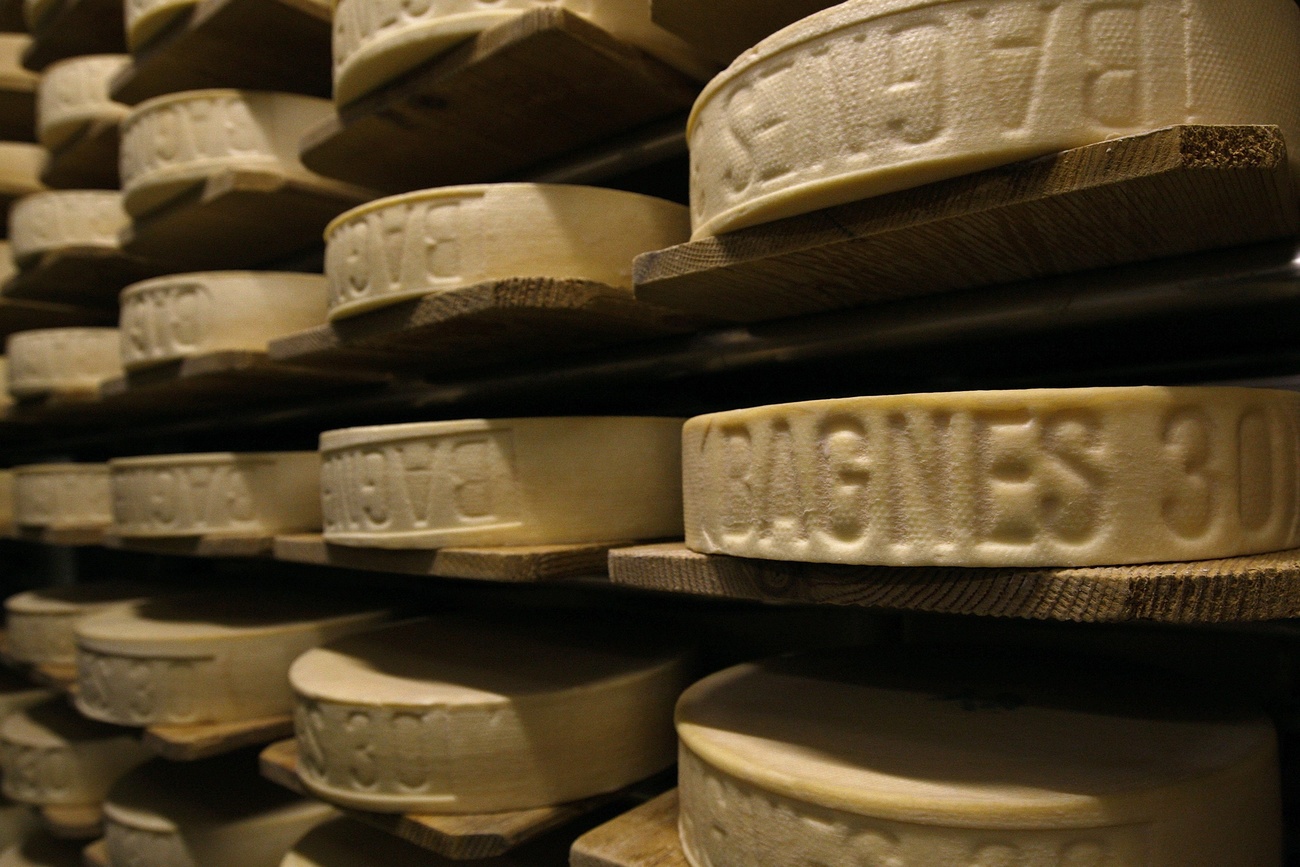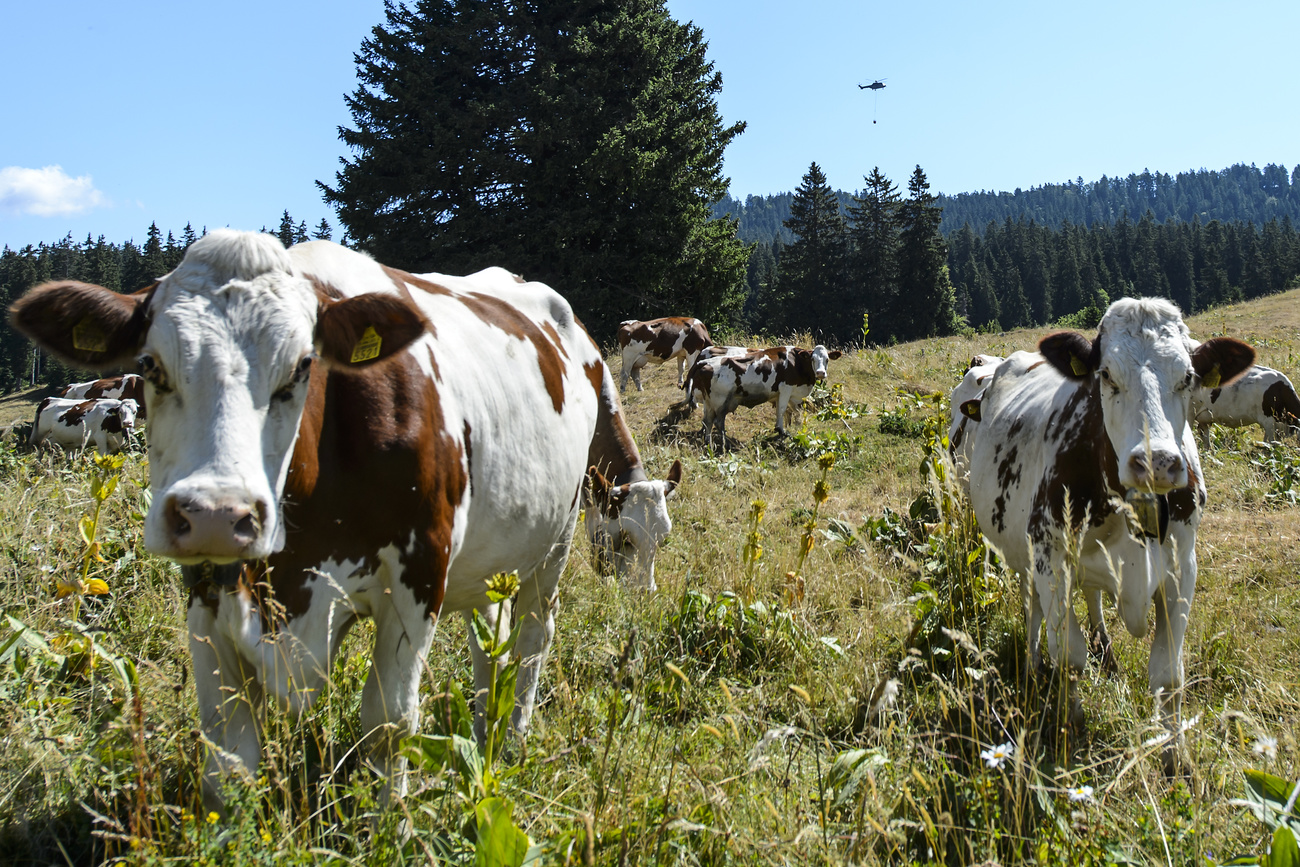
Why Swiss dairy culture is under threat

For the first time, Swiss imports of foreign cheeses are set to outstrip the volume of exports of “Swiss-made” cheeses. This imbalance casts a shadow over the country’s rich dairy tradition, as more and more milk producers are calling it a day.
In July, Boris Beuret, the president of the association of Swiss milk producers (Swissmilk), set off shock waves when he announced in an interviewExternal link with the daily Le Temps that in 2023 Switzerland would be importing more cheese (in tonnes) than it exported. “I’ve received reactions to this news from all over the world,” says the 46-year-old from the Jura region. “Swiss expatriates in Las Vegas wrote to say they were dismayed.”
Monique Perrottet of the umbrella organisation Switzerland Cheese Marketing confirms this trend: “The gap between imports and exports has been closing since the liberalisation of the markets in 2007. Imported cheeses are much cheaper than Swiss products.”
“When the cheese market was liberalised 16 years ago, cheeses arrived in our shops – from the Netherlands, for instance – that cost 30% less. Their sales have continued to grow,” Beuret says. Of course, the principle of free trade means that Swiss cheeses can be exported in return. But international sales of expensive Swiss produce, aimed at a niche market, remain low.
Fewer and fewer farms
Dwindling exports are prompting more and more milk producers to throw in the towel. Their shaky situation is compounded by the price of milk, which the industry deems far too low. Despite having risen steadily since 2009, the farm-gate price of milk stood at CHF0.75 ($0.80) per kilo in 2022 – well below the CHF1 demanded by producers. “Today’s prices do not cover production costs. Farmers cannot make ends meet and are shutting down production,” says Beuret.
The overall number of dairy farms is thus falling twice as fast as in other agricultural sectors. Between 1950 and 2022, it dropped by 87%, from 138,380 to 17,603, according to Swissmilk’s 2022 reportExternal link. At this rate, there will be only 2,000 farms left by 2095.
This bleak outlook is stoking passions among the population, for milk production is closely interwoven with Swiss identity. The country’s longstanding tradition can be explained primarily by its rugged terrain, which is not suited to the large-scale cultivation of grain. “Switzerland’s climate is moreover ideal for pastureland, which accounts for some 80% of all agricultural land. And the best method found so far for transforming grass into food is to feed it to cows that turn it into milk,” Beuret says with a smile.
Subsidies boost profit margins
Swiss producers face significantly higher costs than their foreign competitors. There are several reasons for this. Farms are still small, with an average of 29 headsExternal link per 30 hectares. The economies of scale achieved in Spain, for example, with herds of some 400 cows, are thus impossible. On top of this come the cost of labour and other expenses, which are high in Switzerland compared with other countries.
Urs Niggli, the president of the Agroecology.science institute in Frick, canton Aargau, highlights the quality of the cheese sectorExternal link, as certified by the federal body Agroscope. “Switzerland has a unique range of cultures for the production of raw milk cheeses,” he says. “With the organic food boom in the 1990s, the variety of cheeses increased further still, thanks in particular to small dairies and on-farm processing.” But this know-how is now under risk.
Around 20% of farmers’ incomes comes from subsidies and direct payments from the federal government. Without this state support, many farms would not be able to keep going.
“This money is not a gift, but it is tied to a very complex set of requirements in terms of landscape preservation, biodiversity and water quality, above all,” Beuret stresses.
Like other industry observers, the French-speaking Swiss consumer protection organisation, the Fédération romande des consommateurs (FRCExternal link), believes that agricultural subsidies, which are supposed to support local producers, are in fact fuelling distributor margins, with no benefits for consumers.
Unknown distributor margins
According to the Federal Office for Agriculture, retail giants Coop and Migros (with its subsidiary Denner) account for 76% of all food salesExternal link (2020 figures). These chains are thus clearly in a position of strength when it comes to negotiating prices.
Thierry*, a farmer from the canton of Fribourg, explains: “If my farm gets by, it’s only thanks to agricultural subsidies. The big distributors follow a short-sighted pricing policy. The system cannot work if prices don’t cover production costs.” In Thierry’s village, the number of milk producers has plummeted from 12 to four over the past 20 years. “Our position of power with the retailing and distribution industry is completely unbalanced,” he says.
The major chains, meanwhile, remain tight-lipped about their share of the pie. One can only estimate the amounts involved. Thus, a surveyExternal link published by Le Temps in June 2023 found that gross profit margins fluctuated between 46% and 57%. In comparison, the gross margin on dairy products in France stood at 24.3% of turnover, according to the 2022 report by the French food sector price and margin surveillance body (the Observatoire français de la formation des prix et des marges). As a result, the FRC is campaigning for greater transparencyExternal link on the capital gains made from the sale of food products.
“Coop pays market prices and treats its suppliers fairly. We make a profit of 1.7 centimes per franc of sales, which is low compared with profit-oriented companies”, says Coop spokesperson Caspar Frey.
“In other sectors, businesses are posting margins of 10% or more, without being asked to reveal their cost structures. Why should retailers be the only ones that have to be transparent?” says Migros spokesperson Tristan Cerf.

Individual responsibility
Dairy producers, meanwhile, are adamant that the profits must be better distributed in order to guarantee the future of the industry.
“Milk production makes a major contribution to our country’s food sovereignty, as clearly shown during the Covid crisis and with the war in Ukraine. But these production levels can only be maintained if every stakeholder along the value chain benefits,” says Perrottet of Switzerland Cheese Marketing.
Beuret is appealing to consumers to help rectify the situation. “Individual choices have a huge impact on the plight of the farmers. People need to know what they are buying when they choose Dutch Edam cheese over Swiss gruyère.”
According to the standards in force in the Netherlands, for instance, cows there do not each have a place to lie down in the cowsheds. In Switzerland, this is imposed by law. Water protection standards are also much less restrictive.
“Ultimately, it is the customer who has the final say,” concludes Beuret.
* Not his real name; identity known to the editorial staff.
Edited by Samuel Jaberg. Translated from French by Julia Bassam.
“As a result of the war in Ukraine, the market share of organic products has fallen slightly across Europe, after 20 years of growth. It has now stabilised at around 8% of the total,” says Urs Niggli, an internationally renowned Swiss agronomist. In 2022, the share of organic products on the Swiss dairy market stood at 9%External link.
Organic food is more expensive as productivity is 5 to 15% lower than in standard production. “The use of cheaper concentrated feed is very limited (maximum 5% of the feed ration). And the organic sector works with cows whose genetics are geared towards a better quality of life rather than maximum performance.”
The lifespan of the animals also plays a role, for the cows are not slaughtered after their third lactation, as in factory farming. The low use of antibiotics has a further impact on production levels.

In compliance with the JTI standards
More: SWI swissinfo.ch certified by the Journalism Trust Initiative





























You can find an overview of ongoing debates with our journalists here . Please join us!
If you want to start a conversation about a topic raised in this article or want to report factual errors, email us at english@swissinfo.ch.